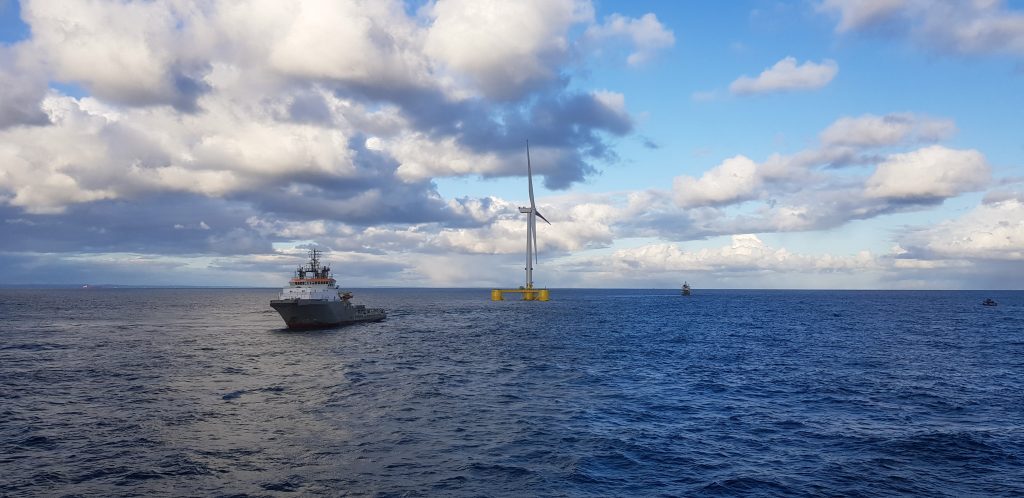- $1.2 Trillion+ opportunity for Floating Offshore Wind (FOW) developers globally says UK report[1]
- FOW developers urged to learn lessons from European deployment
As the global wind industry prepares for GWEC’s Wind Energy Summit in South Korea later this week, Principle Power and Shoreline Wind demonstrate how Floating Offshore Wind (FOW) has moved forward as a result of its almost ten-year partnership and collaboration, ready for FOW developers to take advantage of the opportunities in the Asia-Pacific region and globally.
The Global Wind Energy Council expects the Asian offshore market to have installed nearly 100 GW of offshore wind capacity by 2030, of which the floating category will be a substantial percentage. FOW enables harvesting the strongest wind resources closest to demand centers in the Asia-Pacific region, presenting an opportunity for countries such as South Korea, Taiwan, Japan, and the Philippines. The predicted growth of FOW in places like Asia-Pacific is, to a large degree, enabled by the proven experience gained through the deployment of floating wind projects in Europe, where Principle Power has 75 MW operating and another 30 MW under construction.
Principle Power has pioneered the development of floating wind technology since 2007. In 2016, Principle Power selected Shoreline’s simulation solutions, recognizing that planning commercial scale wind farms requires the ability to accurately represent the many inherent complexities and dependencies that go into the logistics to build and operate projects in different geographies.
Principle Power was already equipped with five years of operational data from the first pilot project WindFloat 1 off the coast of Portugal, as well as the processes and method statements for projects like WindFloat Atlantic. Shoreline brought its expertise acquired from providing advanced simulations for traditional (fixed) offshore wind from around the world and had already developed a solution (Shoreline Design) that could simulate the design, construction and ongoing operations and maintenance of offshore wind projects. Together, Shoreline and Principle Power collaborated to extend Shoreline’s Construction DesignTM and Operations DesignTM software to be able to realistically simulate the operations required to deliver utility-scale floating wind projects.
Principle Power uses Shoreline’s simulations, in combination with internal databases, to help developers plan operations for many different projects across the world, including the 30 MW Fukushima Forward project in Japan, the 1.2 GW Korea Floating Wind project in Korea, and several projects in Taiwan. The analysis and simulation of each project helped to identify requirements and bottlenecks for robust planning and are used to optimize costs and performance. They can also stress test project execution plans to understand the potential impact of sensitivity scenarios and mitigating contingency plans. The results, which are based on real-world experience, help to build confidence in scaling up floating offshore wind projects to commercial scale in new markets around the world.

Michael Bjerrum, Co-founder and COO at Shoreline said:
“There are many features in Shoreline’s product today, dedicated to FOW, which have come because of input from users like Principle Power, and other such pioneers. The dependencies for FOW are unique and very different to traditional fixed offshore wind projects. For example, project developers are faced with the decision about whether to perform wind turbine major component repairs in-situ or by towing platforms to a local port. The appropriate type of intervention depends on the component to be exchanged and trade-offs such as weather sensitivity, port availability, vessel and crane mobilization times, etc. need to be analysed to characterize the costs and risks. Our software delivers the requirements specified by companies like Principle Power for simulating floating wind projects, giving us a competitive edge and helping us to support the industry advance more confidently to commercial scale.”
Inês Serras Pereira, LCoE and Business Intelligence Lead at Principle Power said:
“Combining our real-world data from deployment and operations of floating offshore wind projects with Shoreline’s advanced simulation technology, helps us deliver feasible execution and O&M planning to our clients. By accounting for the complex interdependencies between quayside and offshore operations, and considering the inherent variability of weather offshore, we ensure that we provide best case schedules for commercial-scale projects that are deliverable. This provides an excellent starting point for optimization and contingency planning, helping our clients to prioritize the most cost and revenue effective approaches throughout the lifetime of wind projects.”
Ocean Winds contracted Shoreline Computerised Maintenance Management System (CMMS) solution (CMMS) for its deployment at WindFloat Atlantic, where Principle Power is providing platform inspection, maintenance, and repair services.
Thanks to its contract through WindFloat Atlantic, Shoreline and Principle Power will continue to collaborate to make sure that the simulation capabilities keep pace with the many developments in floating offshore wind such as the in-situ repair that was recently completed at Kincardine.
FOW developers across the world should look to adopt the wealth of expertise gained from pioneering projects already operational across Europe. Real-world experiences from partners, combined with bespoke FOW simulation technologies, are instrumental to unlock the full potential of the GWs of deepwater wind resources that are necessary for APAC nations to meet global renewable energy targets.
[1] Report published October 2024, entitled – Floating Wind: Anchoring the next Generation Offshore. Offshore Wind industry is expected to reach £1 Trillion / $1.2 Trillion by 2050
Building, Design & Construction Magazine | The Choice of Industry Professionals





